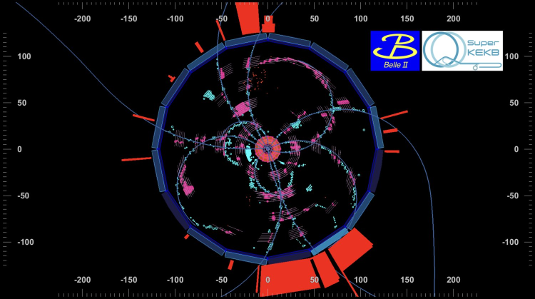Bachelor Thesis Topics
Search for resonant structures in B -> D(*) n*pi decays
For the measurement of semileptonic B meson decays (B -> Dx l nu) there is a discrepancy between the inclusively measured rate and the sum of exclusively measured rates. A possible explanation would be he decay in heavy D mesons (Dh) that produce a light D meson and multiple pions in the final state. Those were not yet considered in measurements of semileptonic B meson decays. The goal of this work is to reconstruct the decay B -> D(*) n*pi with n>=4 to search for signatures of the decay of a heavy D meson.
Search for B decays with baryon number violation by two units
A precondition for the generation of a matter-antimatter asymmetry in our universe is baryon number violation. While the violation of baryon number by one unit (∆B = 1) involving quarks of the first or second generation is severely constrained by the non-observation of proton decay, limits on baryon number violating processes involving third generation quarks are considerably weaker. Processes violating baryon number by two units are even less studied. With Belle II data we can search for ∆B = 2 processes, such as B meson decays to a deuteron and light mesons or leptons.
Determination of B meson quantum numbers
It is well known and often assumed that, according to the quark model, the ground state B mesons are pseudoscalar mesons. Interestingly, the spin and parity of the B mesons were never explicitly measured. With an angular analysis the quantum numbers of B mesons should be measured at Belle II.
Development of a fit model for B -> D** l nu decays
With semileptonic B meson decays parameters of the standard model are measured and lepton universality is tested. An important background for many measurements are semileptonic B meson decays in excited D mesons. Because these D** mesons decays strongly and have a significant width, different D** states can interfere with each other. For a measurement of B -> D** l nu decays with Belle II data a model that takes into account the interference effects should be developed and verified.
Test of a new data format for Belle II analyses
Belle II aims at recording 50 ab-1 of data during its running time which corresponds to approximately 50 times the amount data of its predecessor experiments. To process this large amount of data efficiently the processing must be optimized. This work aims at testing a new data format, the RNtuple, for the application at Belle II. The work is divided into a technical part where the new data format is integrated in the Belle II software, and an analysis part where the performance of the new data format is tested with the reconstruction of a specific B meson decay. Knowledge of C++ would be beneficial, but are not strictly required and can be acquired during the thesis work.
Belle II software sheckpointing
Large computing resources are required for the processing and generation of data for the Belle II experiment. In case of use of regenerative sources of energy their availability varies in time. For an optimal use of regenerative energy it is desirable that programs can be stopped and continues later. This checkpointing called feature should be implemented in the Belle II software. The project requires good knowledge of C++-.
Belle II open data analysis
In future, data from electron positron collisions that are recorded by the Belle II experiment should be made publicly available. The goal is to make particle physics accessible to pupils and students . Based on an existing analysis a comprehensible analysis example in form of a jupyter notebook should be developed. This notebook should on the one hand present the physical topic and on the other hand explain the the individual steps of the data analysis in a didactic way. the presentation should be such that it is understandable by non-experts. The goal of the bachelor thesis is on the one hand the illustration of physical problems and on the other hand the application of modern data analysis tools. As inspiration and guideline the existing open data analysis examples of other experiments can be reviewed, for example on the CERN Open Data Portal.
Further topics may be available.
For the bachelor thesis topics in the summer semester we offer an educational program. In particular the introductory course in the first week of the semester is highly recommended.
The formalities for bachelor theses are explained on the page of the examination office.





